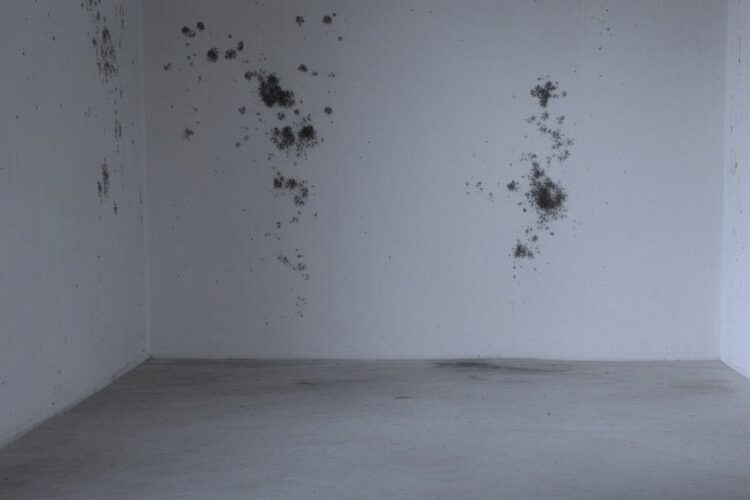Black mold (Stachybotrys chartarum) is a toxic fungus that grows in damp, humid homes, releasing mold spores and mycotoxins that harm health. Exposure can cause allergies, asthma, chronic sinusitis, respiratory issues, and, in rare cases, neurological symptoms or infections, especially in children, the elderly, or immunocompromised people. Poor indoor air quality from water damage or high humidity worsens risks. Prevent mold by keeping humidity below 50%, fixing leaks fast, and improving ventilation. For infestations, clean small areas with protective gear or hire professionals for large ones. Regular inspections and mold-resistant materials help maintain a healthy home. Act quickly to address black mold to protect your health and property.
Long Version
Black mold, scientifically known as Stachybotrys chartarum, is a pervasive concern for homeowners due to its potential to compromise indoor air quality and trigger serious health effects. Often thriving in damp, humid environments, this toxic mold can colonize homes, releasing mold spores, mycotoxins, and volatile organic compounds (VOCs) that pose risks to human health. This article provides a comprehensive exploration of black mold, its health implications, associated risks, and effective strategies for prevention and remediation, offering an authoritative resource for homeowners and health-conscious individuals.
What is Black Mold?
Black mold is a type of microfungus that appears as dark green or black patches, often with a slimy texture. It is one of several mold species, including Aspergillus and Penicillium, that can grow indoors. Stachybotrys chartarum is particularly notorious because it produces mycotoxins—toxic secondary metabolites that can harm humans and animals. Mold thrives in environments with excessive moisture, such as those affected by water damage, leaks, or high humidity levels (above 60%). Common sites for mold colonization include bathrooms, basements, attics, and areas with poor ventilation.
Mold spores are microscopic and airborne, making them easily inhalable. When disturbed, black mold releases bioaerosols, which are particles containing mold spores, mycotoxins, endotoxins, and glucans (components of fungal cell walls). These particles contribute to poor indoor air quality and are linked to a range of health issues, from mild allergic reactions to severe respiratory and immunological conditions.
Health Effects of Black Mold Exposure
Exposure to black mold can lead to a spectrum of health effects, depending on the duration, intensity, and individual susceptibility. Below, we explore the primary health risks associated with black mold, categorized by their severity and affected systems.
1. Allergic Reactions and Sensitivities
For many individuals, black mold exposure triggers allergic responses. Common symptoms include:
- Allergic rhinitis: Sneezing, runny nose, and nasal congestion.
- Itchy eyes and skin: Red, watery eyes and skin irritation.
- Asthma exacerbation: Mold spores can worsen asthma symptoms, causing wheezing, shortness of breath, and chest tightness.
These symptoms arise when the immune system reacts to mold spores or glucans. Individuals with pre-existing allergies or asthma are particularly vulnerable, and prolonged exposure may lead to heightened sensitivity.
2. Respiratory Issues
Black mold is a known respiratory irritant. Inhalation of mold spores and mycotoxins can cause:
- Chronic sinusitis: Persistent sinus infections or inflammation, often resistant to standard treatments.
- Coughing and throat irritation: A dry, scratchy throat or persistent cough.
- Hypersensitivity pneumonitis: A rare but serious lung inflammation caused by repeated exposure to bioaerosols, leading to flu-like symptoms, fatigue, and lung scarring.
Respiratory issues are especially concerning in homes with poor ventilation, where mold spores accumulate in the air. Children, the elderly, and those with compromised respiratory systems face higher risks.
3. Toxic Effects of Mycotoxins
Mycotoxins produced by Stachybotrys chartarum are particularly harmful because they can disrupt cellular function. While mycotoxin poisoning (mycotoxicosis) is rare, prolonged exposure to high concentrations may cause:
- Neurological symptoms: Headaches, dizziness, memory problems, and difficulty concentrating.
- Immunosuppression: Weakened immune responses, increasing susceptibility to infections.
- Fatigue and malaise: Persistent feelings of tiredness or weakness.
The severity of mycotoxin-related symptoms depends on the concentration of toxins and the duration of exposure. Homes with extensive water damage or mold colonization are more likely to have elevated mycotoxin levels.
4. Fungal Infections
In rare cases, black mold exposure can lead to fungal infections, particularly in immunocompromised individuals (e.g., those with HIV/AIDS, cancer, or organ transplants). Aspergillus-related molds, which sometimes coexist with black mold, are more commonly associated with infections like aspergillosis, which affects the lungs and other organs. Symptoms include fever, chest pain, and coughing up blood.
5. Sick Building Syndrome
Black mold is a key contributor to sick building syndrome, a condition where occupants experience health symptoms linked to time spent in a specific building. Poor indoor air quality, high humidity, and mold growth create an environment where occupants may suffer from headaches, fatigue, respiratory issues, and skin irritation. This phenomenon is common in older buildings, poorly maintained homes, or structures with unresolved water damage.
Vulnerable Populations
Certain groups are more susceptible to the health effects of black mold:
- Children: Developing immune and respiratory systems make children more prone to allergies, asthma, and infections.
- Elderly: Age-related declines in immune function increase risks of respiratory and systemic symptoms.
- Immunocompromised individuals: Those with weakened immune systems face higher risks of fungal infections and mycotoxin-related issues.
- People with pre-existing conditions: Asthma, chronic obstructive pulmonary disease (COPD), or allergies heighten sensitivity to mold exposure.
The Role of Indoor Air Quality
Indoor air quality is a critical factor in black mold-related health risks. Mold spores, VOCs, and bioaerosols degrade air quality, especially in homes with poor ventilation or high humidity. Factors contributing to poor indoor air quality include:
- Water damage: Leaks, floods, or burst pipes create ideal conditions for mold growth.
- High humidity: Levels above 60% promote mold colonization.
- Inadequate ventilation: Stagnant air allows mold spores to accumulate.
- Contaminated HVAC systems: Mold can spread through heating, ventilation, and air conditioning systems, distributing spores throughout the home.
Diagnosing Black Mold Exposure
Diagnosing health issues related to black mold can be challenging, as symptoms often mimic those of other conditions. If you suspect mold exposure, consider the following steps:
- Symptom tracking: Note symptoms like chronic sinusitis, respiratory issues, or fatigue, especially if they worsen indoors.
- Home inspection: Look for visible signs of mold (black patches, musty odors) or water damage.
- Medical evaluation: Consult a healthcare provider for allergy testing, blood tests, or imaging to assess respiratory health.
- Environmental testing: Hire a professional for a mycological assessment, which involves air sampling, surface testing, and humidity measurements to confirm mold presence.
Preventing Black Mold in Homes
Preventing black mold is far easier than remediating an established infestation. Here are evidence-based strategies to maintain a mold-free home:
1. Control Humidity
- Keep indoor humidity below 50% using dehumidifiers or air conditioners.
- Use hygrometers to monitor humidity levels in high-risk areas like basements and bathrooms.
- Ventilate high-moisture areas with exhaust fans during cooking, showering, or laundry.
2. Address Water Damage Promptly
- Repair leaks in roofs, pipes, or windows immediately.
- Dry water-damaged areas within 24–48 hours to prevent mold growth.
- Use moisture-resistant materials (e.g., mold-resistant drywall) in flood-prone areas.
3. Improve Ventilation
- Install exhaust fans in bathrooms and kitchens to reduce moisture buildup.
- Ensure proper airflow in attics and crawlspaces with vents or fans.
- Clean and maintain HVAC systems regularly to prevent mold spread.
4. Regular Cleaning and Maintenance
- Clean bathrooms, kitchens, and other damp areas with mold-inhibiting cleaners.
- Inspect and replace HVAC filters monthly, using HEPA filters to trap mold spores.
- Remove carpets from bathrooms or basements, as they can trap moisture.
5. Monitor for Mold
- Conduct routine inspections for musty odors, discoloration, or water stains.
- Consider professional mold inspections in older homes or after flooding.
Mold Remediation: Addressing an Infestation
If black mold is detected, prompt remediation is essential to protect health and prevent structural damage. Here’s a step-by-step guide to effective mold removal:
1. Assess the Extent of Infestation
- Small areas (less than 10 square feet) can often be handled by homeowners with proper precautions.
- Large infestations or hidden mold (e.g., behind walls) require professional mold remediation services.
2. Contain the Area
- Seal off affected areas with plastic sheeting to prevent spore spread.
- Use negative air pressure machines to filter and exhaust contaminated air.
3. Remove Contaminated Materials
- Dispose of porous materials (e.g., drywall, carpet, insulation) that cannot be salvaged.
- Clean non-porous surfaces (e.g., tile, metal) with EPA-approved mold cleaners.
4. Dry and Disinfect
- Thoroughly dry the area using fans and dehumidifiers.
- Apply antimicrobial treatments to prevent regrowth.
5. Restore and Prevent
- Replace damaged materials with mold-resistant alternatives.
- Address underlying moisture issues to prevent recurrence.
Note: Always wear protective gear (N95 masks, gloves, goggles) during remediation to avoid exposure to mold spores and mycotoxins.
Professional Mold Remediation Services
For extensive mold problems, hiring a certified mold remediation specialist is recommended. These professionals conduct:
- Mycological assessments to identify mold species and concentrations.
- Air and surface sampling to evaluate contamination levels.
- Comprehensive removal and restoration, ensuring compliance with environmental regulations.
Look for certifications from organizations like the Institute of Inspection, Cleaning and Restoration Certification (IICRC) or the National Organization of Remediators and Mold Inspectors (NORMI).
The Bigger Picture: Mold and Public Health
Black mold is not just a household issue—it’s a public health concern. Poorly maintained buildings, especially in low-income housing or older structures, can exacerbate health disparities by exposing residents to toxic mold. Advocacy for better building codes, regular inspections, and tenant protections can reduce mold-related health risks on a societal level.
Additionally, climate change is increasing the prevalence of mold by driving more frequent flooding and humidity spikes. Homeowners and policymakers must prioritize resilient building designs and proactive mold prevention to mitigate these risks.
Conclusion
Black mold (Stachybotrys chartarum) is a formidable threat to indoor air quality and human health, capable of causing allergic reactions, respiratory issues, mycotoxin-related symptoms, and even sick building syndrome. Vulnerable populations, including children, the elderly, and immunocompromised individuals, face heightened risks. By understanding the dangers of mold spores, mycotoxins, and bioaerosols, homeowners can take proactive steps to prevent infestations through humidity control, prompt water damage repairs, and regular maintenance.
When mold does appear, swift remediation—whether DIY or professional—is critical to safeguarding health and property. By combining vigilance, science-based prevention, and timely intervention, you can protect your home from the insidious effects of black mold and ensure a healthier living environment. For ongoing concerns or complex cases, consult certified professionals and stay informed about the latest advancements in mold prevention and indoor air quality management.
Hashtags For Social Media
#blackmold #moldhealthrisks #moldexposure #toxicmold #moldawareness #healthhazards #indoorairquality #moldprevention #moldremediation #molddanger #healthyhome #moldissues #homehealth #moldcleanup #moldfacts #moldproblems #moldrisks #moldeducation #moldhealth #moldwarnings #homeinspection #moldtoxicity #moldsickness #moldremoval #moldconcerns #healthyliving #moldalert #moldgrowth #moldeffects #moldfreehome
Related Questions, Words, Phrases
black mold health dangers | risks of black mold exposure | health hazards of black mold | black mold and health issues | dangers of black mold to health | black mold health concerns | health risks from black mold | black mold exposure risks | black mold health threats | health problems from black mold | black mold and health hazards | risks to health from black mold | black mold health implications | health dangers of black mold exposure | black mold and health risks | black mold health effects | health issues caused by black mold | black mold and health dangers | health risks of black mold growth | black mold health consequences | risks of black mold on health | black mold and health problems | health threats from black mold | black mold health worries | health risks associated with black mold








